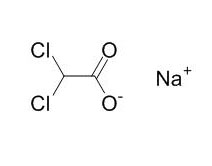Sodium Dichloroacetate
Sodium dichloroacetate is a drug with potential for treating patients with stroke and head injury. Sodium dichloroacetate exhibits anti-leukemic activity in B-chronic lymphocytic leukemia (B-CLL) and synergizes with the p53 activator Nutlin-3; it is cytoprotective to some colorectal cancer cells under hypoxic conditions.
Inquire / Order:
manager@chemfaces.com
Technical Inquiries:
service@chemfaces.com
Tel:
+86-27-84237783
Fax:
+86-27-84254680
Address:
1 Building, No. 83, CheCheng Rd., Wuhan Economic and Technological Development Zone, Wuhan, Hubei 430056, PRC
Providing storage is as stated on the product vial and the vial is kept tightly sealed, the product can be stored for up to
24 months(2-8C).
Wherever possible, you should prepare and use solutions on the same day. However, if you need to make up stock solutions in advance, we recommend that you store the solution as aliquots in tightly sealed vials at -20C. Generally, these will be useable for up to two weeks. Before use, and prior to opening the vial we recommend that you allow your product to equilibrate to room temperature for at least 1 hour.
Need more advice on solubility, usage and handling? Please email to: service@chemfaces.com
The packaging of the product may have turned upside down during transportation, resulting in the natural compounds adhering to the neck or cap of the vial. take the vial out of its packaging and gently shake to let the compounds fall to the bottom of the vial. for liquid products, centrifuge at 200-500 RPM to gather the liquid at the bottom of the vial. try to avoid loss or contamination during handling.
Antioxidants (Basel).2021, 10(9):1487.
BMC Complement Altern Med.2014, 14:352
Vietnam J. Chemistry2022, 60(2):211-222
Green Chem.2023, 25:5222-5232
Nutrients2020, 12(2):488
Biomed Pharmacother.2024, 181:117658.
Korean J. Crop Sci.2018, 63(2):131-139
Nutr Res Pract.2020, 14(3):203-217.
J Anal Methods Chem.2022, 2022:2229500.
Sci Rep. 2018, 10590
Related and Featured Products
Cancer Lett. 2010 Nov 1;297(1):75-83.
Sodium dichloroacetate (DCA) reduces apoptosis in colorectal tumor hypoxia.[Pubmed:
20537792 ]
METHODS AND RESULTS:
We examined the effect of hypoxia on apoptosis of human colorectal cancer (CRC) cells in vitro and in vivo. All cell lines tested were susceptible to hypoxia-induced apoptosis. Sodium Dichloroacetate (DCA) treatment caused significant apoptosis under normoxia in SW480 and Caco-2 cells, but these cells displayed decreased apoptosis when treated with DCA combined with hypoxia, possibly through HIF-1alpha dependent pathways. DCA treatment also induced significantly increased growth of SW480 tumor xenografts, and a decrease in TUNEL positive nuclei in hypoxic but not normoxic regions of treated tumors.
CONCLUSIONS:
Thus DCA is cytoprotective to some CRC cells under hypoxic conditions, highlighting the need for further investigation before DCA can be used as a reliable apoptosis-inducing agent in cancer therapy.
Oncotarget. 2014 Jun; 5(12): 4347–4360.
Sodium dichloroacetate exhibits anti-leukemic activity in B-chronic lymphocytic leukemia (B-CLL) and synergizes with the p53 activator Nutlin-3[Pubmed:
24962518 ]
METHODS AND RESULTS:
The anti-leukemic activity of the mitochondria-targeting small molecule Sodium Dichloroacetate (DCA), used alone and in association with the small molecule inhibitor of the p53/MDM2 interaction Nutlin-3, was analyzed in primary B-chronic lymphocytic leukemia (B-CLL) samples (n=22), normal peripheral blood cells (n=10) and in p53wild-type EHEB, JVM-2, JVM-3 B lymphoblastoid cell lines. DCA exhibited a dose-dependent anti-leukemic activity in both primary B-CLL and B leukemic cell lines with a functional p53 status and showed a synergistic cytotoxic activity when used in combination with Nutlin-3. At the molecular level, DCA positively regulated p53 activity, as documented by post-transcriptional modifications of p53 protein, and synergized with Nutlin-3 in increasing the expression of the p53-target genes MDM2, PUMA, TIGAR and in particular p21. The potential role of p21 in mediating the DCA+Nutlin-3 anti-leukemic activity was underscored in knocking-down experiments. Indeed, transfection of leukemic cells with p21 siRNAs significantly decreased the DCA+Nutlin-3-induced cytotoxicity.
CONCLUSIONS:
Taken together, our data emphasize that DCA is a molecule that merits to be further evaluated as a chemotherapeutic agent for B-CLL, likely in combination with other therapeutic compounds.
Fundam Appl Toxicol. 1996 Jul;32(1):87-95.
Absence of mutagenic effects of sodium dichloroacetate.[Pubmed:
8812237]
Sodium Dichloroacetate (DCA) is a drug with potential for treating patients with stroke and head injury. Conflicting evidence has been published on the mutagenic potential of DCA.
METHODS AND RESULTS:
A series of genetic tests for mutagenicity and clastogenicity was carried out on pharmaceutical grade DCA. Four types of mutagenicity test were included, with and without metabolic activation where appropriate. These studies included: (i) Salmonella and Escherichia coli mutation (Ames) test, (ii) thymidine kinase locus forward mutation in L5178Y mouse lymphoma cells, (iii) tests for chromosomal aberrations in Chinese hamster ovary cells, and (iv) and in vivo rat bone marrow erythroid micronucleus test. In each study, there was no evidence of mutagenic activity attributable to DCA. It is possible that the present test material, of pharmaceutical grade, has fewer impurities than materials studied in previous reports.
CONCLUSIONS:
These data extend, and in some cases contradict, previous published reports on DCA.



